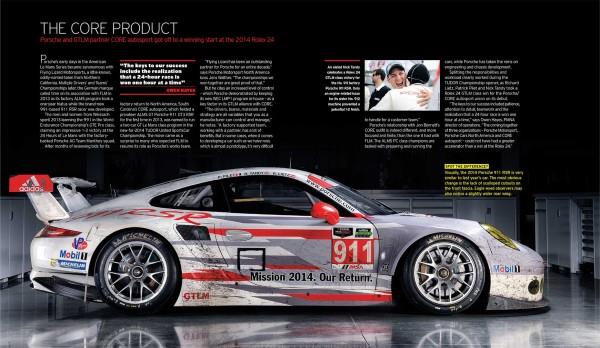Most of us associate car photography with chrome and meticulously polished metal. But the Porsche GT that Richard Dole shot had just won a 24-hour long Daytona race and was far from clean. It was covered in dirt and grit. Keep reading to learn how he got his shot.

The 24 Hours of Daytona is a 24-hour sports car endurance race held annually at Daytona International Speedway in Daytona Beach, Florida. Needless to say, the 24-hour long race takes its toll on the racecars. By the time they cross the finishing line, they are covered in dirt and grit.
This year, a Porsche GT from CORE Autosport in Rock Hill, South Carolina, was the first car to cross the finishing line. This car was also the one photographer Richard Dole was asked to shoot on behalf of RACER Magazine.
“This was an unusual assignment,” says Richard. “They wanted me to photograph the car still covered with the dirt, oil, rubber, grease and grime accumulated from the race. And it had to be photographed not in a studio, but in the winning team’s race shop.”



Shooting a car is not an easy thing to do. Cars are big, reflective and have almost no flat surfaces. This particular shoot was even more challenging, as Richard had to shoot the Porsche on location at the CORE facility – a bright and busy workspace with an abundance of windows, lamps and white metal cabinets.
Richard was given one of the facility’s working bays to set up his lights and get his shot. Here is how he did it:
“I feel the best way to light a racecar is to start from above and work down,” says Richard. “Space was tight, but the solution was really simple. My main lights were two Profoto D1 monolights, each attached to a Softbox RFi 4×6’, and placed on rolling boom stands. This combination gave me a beautiful light that I could control (with the Air Remotes) and move (with the rolling stands) easily, quickly, and most importantly, precisely.
“So for each shot, the overhead lighting was dialed in first. Next came the fill lights. This was accomplished with a Profoto Pro-7b battery pack with two heads, and two AcuteB2 battery packs with one head each, along with small softboxes, reflectors, and grids.


“The amount of gear used varied greatly throughout the shoot. Some of the images required every pack and every head, and others required far less. For example, the photograph of the rear spoiler with the Porsche logo was shot with one D1 above the spoiler and a gold reflector on the ground.
“To sum it up, the entire range of Profoto gear – from the flexibility of the Air Remote, to the consistent quality of light when combining D1 monolights and RFi softboxes – allowed me to turn a small section of a race shop into a studio and produce some beautiful images of a legendary Porsche.”
See more of Richard work at his website.


